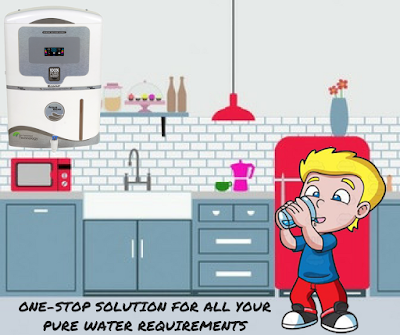Fundamentals of ORP and pH
Oxidation reduction potential (ORP)
Oxidation
reduction potential generally called Redox potential is a parameter which
measures the quality of water. It exhibits the capacity of the substance to
reduce or oxidize another substance. Accordingly, ORP chooses how much degree a
given solution is set up to either acknowledge or release electrons through
chemical reactions. ORP is measured by the help of ORP meter which has a range
of -2000 to +2000 units expressed in terms of volts (V) or milli volts (mV).
ORP sensor works by measuring the
amount of disintegrated oxygen.
• The
positive (+) ORP reading suggests the solution is an oxidizing agent. The more
positive ORP, the more oxidize the solution is, that suggests the solution has
a higher ability to break up hazardous contaminants from the RO water. For example: if any given solution
exhibits ORP as (+) 200mV, than this solution is 2 times more oxidize than the
solution demonstrates ORP as (+) 100mV.
• The
negative (+) ORP reading suggests the solution is a reducing agent. The more
negative ORP reading, anti-oxidizing the solution is, that suggests the
solution contains less broke up oxygen as the organics are consuming the oxygen.
For example, the solution with ORP (-) 200mV is 2 times more anti-oxidizing
than a solution with ORP (-) 100mV.
But
'alkaline ionized' water, most unique sorts of water are an oxidizing agent
(ORP value is positive). Alkaline ionized water has negative ORP value,
indicates it as an anti-oxidizing administrator, and it can release its extra
electrons that destroys the toxic nature of free radicals.
Potential hydrogen (pH)
pH value demonstrates
the hydrogen concentration which decides the quality of the water we get from water purifier, regardless of whether the
arrangement is basic or acidic or neutral. It is measured by the pH scale, and
its index value is related to the extent of positive hydrogen particles (H+)
and negative hydroxyl particles (OH-).
• The
solution is called acidic (i.e. pH value <7), when the concentration of H+
particles is higher than OH-particles.
• The
solution is called alkaline (i.e. pH value >7), if the concentration of
OH-particles are higher than H+ particles.
• The
solution is called neutral (i.e. pH value = 7), when the concentration of
OH-and H+ particles are comparable.
The pH value
is appeared in logarithmic scale. Therefore, when the pH value increments or
decreases by 1unit, it suggests the concentration of hydrogen particles changes
by 10 times. Ex: Solution with pH value 4 is ten times more acidic than a
solution with pH value 5.
Significance of ORP and pH
Higher
positive ORP is suitable for swimming pools, spas, and sewage water as more
oxidation will happen which will diminish each one of the pathogens, and
contaminants. Customarily chlorine is added to drinking water as it has high ORP
and will oxidize and dimish all the risky micro-organisms.
RO water with pH value 6.5 to 8.5 is considered as safe for drinking, as this value
demonstrates that the water is neither acidic nor sufficiently alkaline to be
damaging to human body. Right when pH value drops to underneath 6.5 and besides
increases over 8.5, water turns out to be more poisonous, causes diverse therapeutic
issues like eye and skin irritation, diarrhea, sickness, gastrointestinal
problems, etc.



Comments
Post a Comment